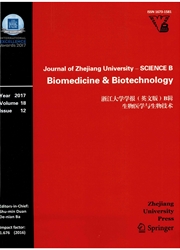

 中文摘要:
中文摘要:
近期红外线(NIR ) 与 chemometrics 技术相结合的光谱学被用来分类与 10% 掺杂的纯月桂树的果实果汁和蜜汁(w/w ) ,(w/w )20% 流水。主分量分析(PCA ) 被使用减少尺寸光谱为光线的基础的数据,关于对象的分离的一个潜在的能力的 give 信息,和 provide 主要成分(PC ) 分数工作神经网络(RBFNN ) 。RBFNN 被用来检测月桂树的果实果汁掺杂物。趋于增加的 scatter 修正(MSC ) 和标准正常变量(SNV ) 转变习惯于 preprocess 系列。结果证明有最佳参数的 PC-RBFNN 能以 97.62% 的识别率把纯月桂树的果实果汁样品与掺杂水的月桂树的果实分开,但是不能清楚地在掺杂的月桂树的果实果汁检测水层次。我们断定 NIR 技术能成功地被使用检测掺杂水的月桂树的果实果汁。
 英文摘要:
英文摘要:
Near-infrared (NIR) spectroscopy combined with chemometrics techniques was used to classify the pure bayberry juice and the one adulterated with 10% (w/w) and 20% (w/w) water. Principal component analysis (PCA) was applied to reduce the dimensions of spectral data, give information regarding a potential capability of separation of objects, and provide principal component (PC) scores for radial basis function neural networks (RBFNN). RBFNN was used to detect bayberry juice adulterant. Multiplicative scatter correction (MSC) and standard normal variate (SNV) transformation were used to preprocess spectra. The results demonstrate that PC-RBFNN with optimum parameters can separate pure bayberry juice samples from water-adulterated bayberry at a recognition rate of 97.62%, but cannot clearly detect water levels in the adulterated bayberry juice. We conclude that NIR technology can be successfully applied to detect water-adulterated bayberry juice.
 同期刊论文项目
同期刊论文项目
 同项目期刊论文
同项目期刊论文
 Classification of tomatoes with different genes by visible and short-wave near-infrared spectroscopy
Classification of tomatoes with different genes by visible and short-wave near-infrared spectroscopy Nondestructive determination of soluble solids content and pH in tomato juice using NIR transmittanc
Nondestructive determination of soluble solids content and pH in tomato juice using NIR transmittanc Combination and comparison of chemometrics methods for identification of transgenic tomatoes using v
Combination and comparison of chemometrics methods for identification of transgenic tomatoes using v Feasibility study on identification of transgenic and non-transgenic tomato seeds using near-infrare
Feasibility study on identification of transgenic and non-transgenic tomato seeds using near-infrare Quantification of chlorophyll content and classification of nontransgenic and transgenic tomato leav
Quantification of chlorophyll content and classification of nontransgenic and transgenic tomato leav 期刊信息
期刊信息
